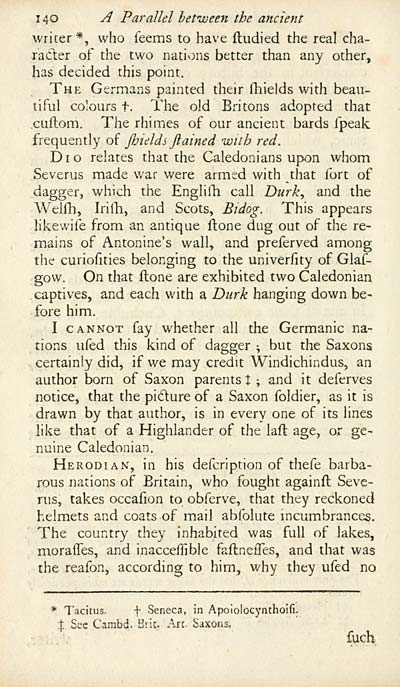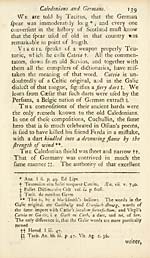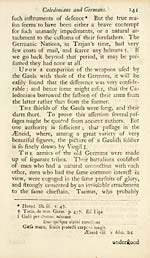Blair Collection > Critical dissertations on the origin, antiquities, language, government, manners, and religion, of the antient Caledonians, their posterity the Picts, and the British and Irish Scots
(178)
Download files
Complete book:
Individual page:
Thumbnail gallery: Grid view | List view

I40 A Parallel between the ancient
writer*, who feems to have ftiidied the real cha-
racter of the two nations better than any other,
has decided this point.
The Germans painted their fhields with beau-
tiful colours t. The old Bi-itons adopted that
cuftom. The rhimes of our ancient bards fpeak
frequently of Jhields Jiained with red.
Dio relates that the Caledonians upon whom
Severus made war were armed with that fort of
dagger, which the EnglilTi call Durk., and the
Welfli, Irifh, and Scots, Bidog. This appears
likewife from an antique ftone dug out of the re-
mains of Antonine's wall, and preferved among
the curiofities belonging to the univerfity of Glaf-
gow. On that ftone are exhibited two Caledonian
captives, and each with a Dark hanging down be-
fore him.
I CANNOT fay whether all the Germanic na-
tions ufed this kind of dagger ^ but the Saxons
certainly did, if we may credit Windichindus, an
author born of Saxon parents X ; and it deferves
notice, that the pidure of a Saxon foldier, as it is
drawn by that author, is in every one of its lines
like that of a Highlander of the laft age, or ge-
nuine Caledonian.
Herodian, in his defcription of thefe barba-
rous nations of Britain, who fought againfl Seve-
rus, takes occafion to obferve, that they reckoned
helmets and coats of mail abfolute incumbrances.
The country they inhabited was full of lakes,
morafles, and inacceflible faftneiTes, and that was
the reafon, according to him, why they ufed no
' Tacitus. f Seneca, in Apoiolocynthoifi.
t Sec Cambd. Brie. Art. Saxons.
fuch.
writer*, who feems to have ftiidied the real cha-
racter of the two nations better than any other,
has decided this point.
The Germans painted their fhields with beau-
tiful colours t. The old Bi-itons adopted that
cuftom. The rhimes of our ancient bards fpeak
frequently of Jhields Jiained with red.
Dio relates that the Caledonians upon whom
Severus made war were armed with that fort of
dagger, which the EnglilTi call Durk., and the
Welfli, Irifh, and Scots, Bidog. This appears
likewife from an antique ftone dug out of the re-
mains of Antonine's wall, and preferved among
the curiofities belonging to the univerfity of Glaf-
gow. On that ftone are exhibited two Caledonian
captives, and each with a Dark hanging down be-
fore him.
I CANNOT fay whether all the Germanic na-
tions ufed this kind of dagger ^ but the Saxons
certainly did, if we may credit Windichindus, an
author born of Saxon parents X ; and it deferves
notice, that the pidure of a Saxon foldier, as it is
drawn by that author, is in every one of its lines
like that of a Highlander of the laft age, or ge-
nuine Caledonian.
Herodian, in his defcription of thefe barba-
rous nations of Britain, who fought againfl Seve-
rus, takes occafion to obferve, that they reckoned
helmets and coats of mail abfolute incumbrances.
The country they inhabited was full of lakes,
morafles, and inacceflible faftneiTes, and that was
the reafon, according to him, why they ufed no
' Tacitus. f Seneca, in Apoiolocynthoifi.
t Sec Cambd. Brie. Art. Saxons.
fuch.
Set display mode to: Large image | Transcription
Images and transcriptions on this page, including medium image downloads, may be used under the Creative Commons Attribution 4.0 International Licence unless otherwise stated. ![]()
| Permanent URL | https://digital.nls.uk/76288569 |
|---|
| Description | A selection of books from a collection of more than 500 titles, mostly on religious and literary topics. Also includes some material dealing with other Celtic languages and societies. Collection created towards the end of the 19th century by Lady Evelyn Stewart Murray. |
|---|
| Description | Selected items from five 'Special and Named Printed Collections'. Includes books in Gaelic and other Celtic languages, works about the Gaels, their languages, literature, culture and history. |
|---|

